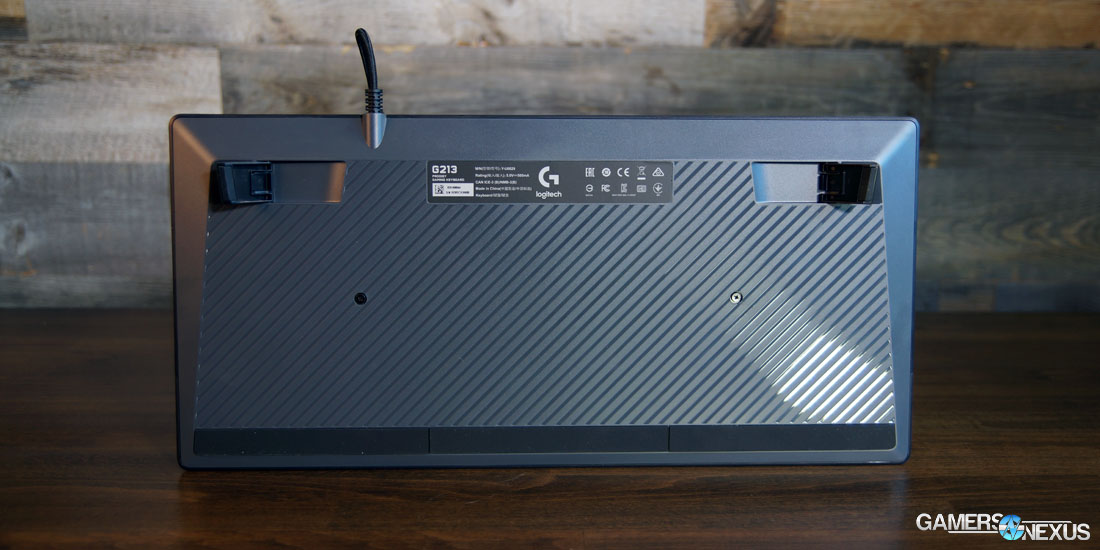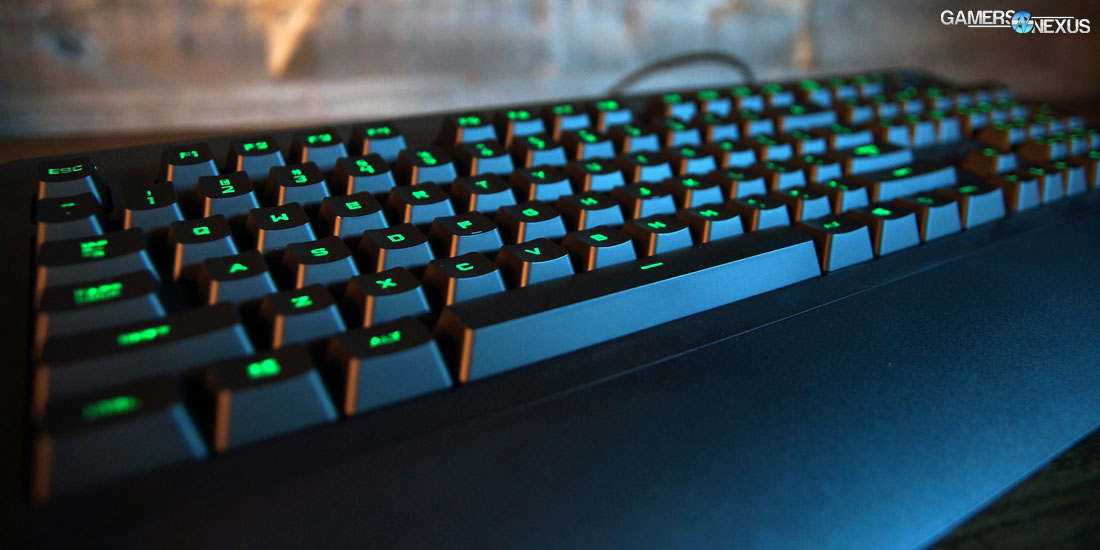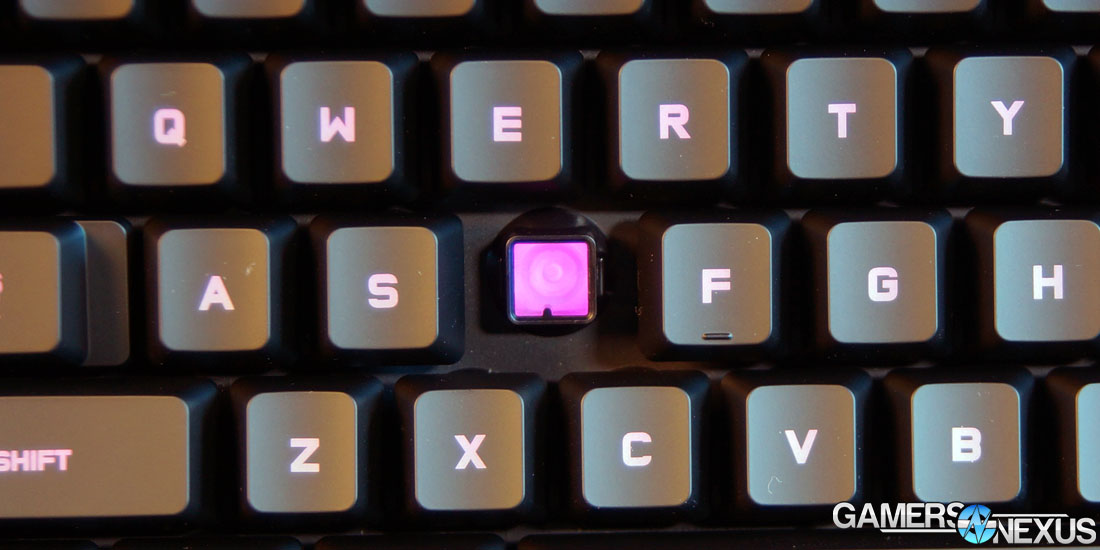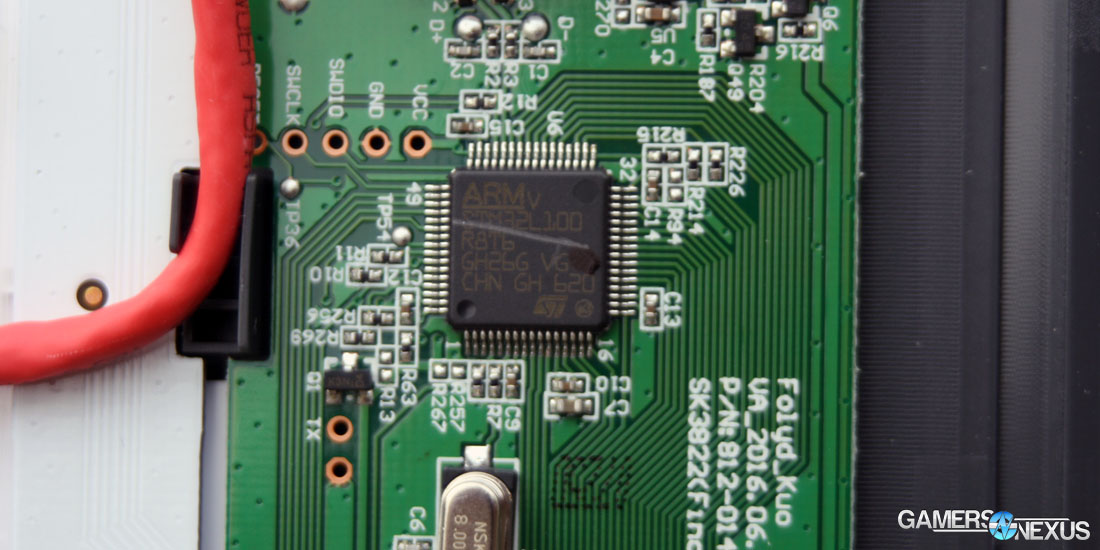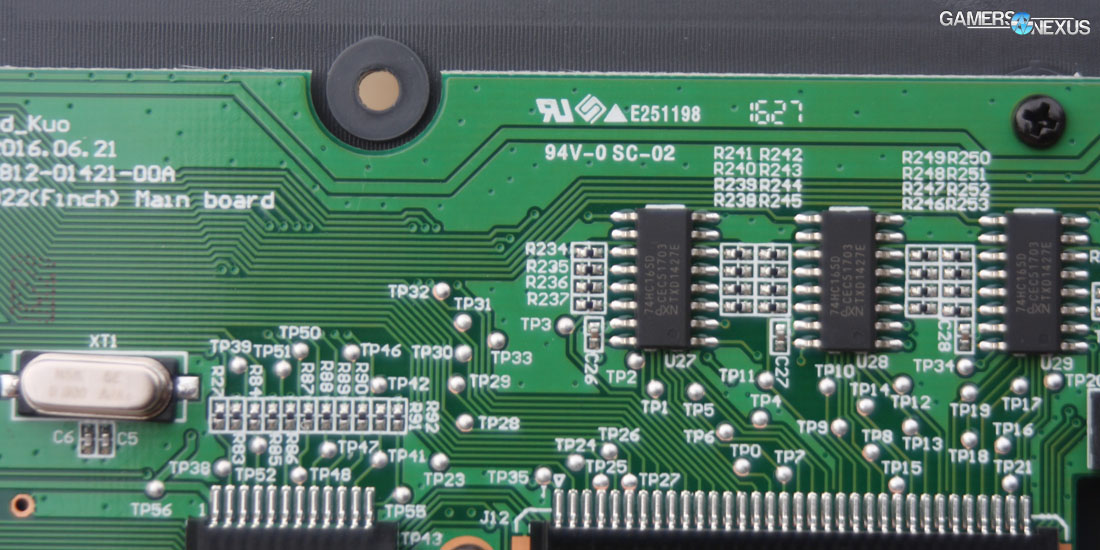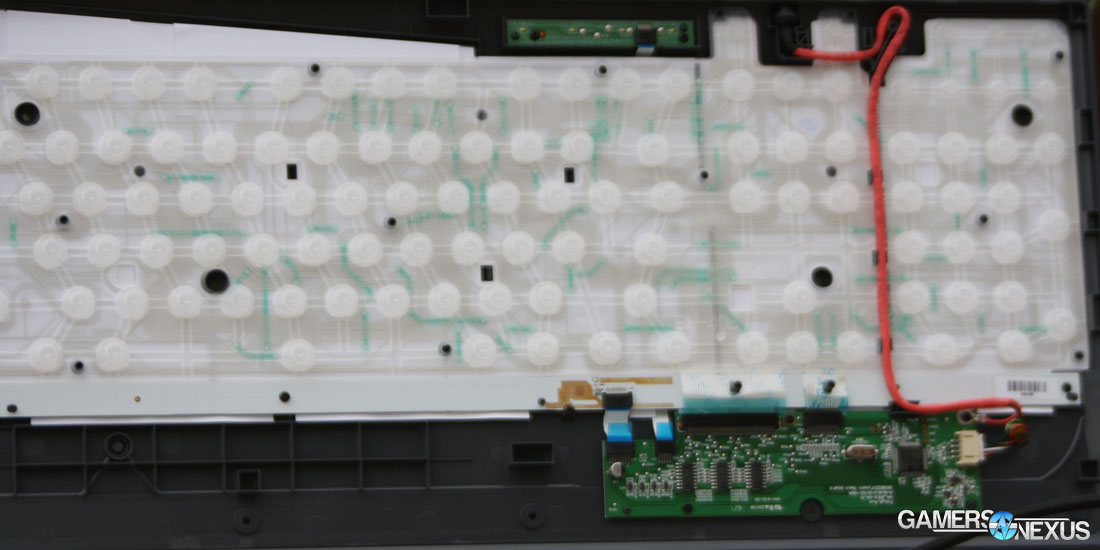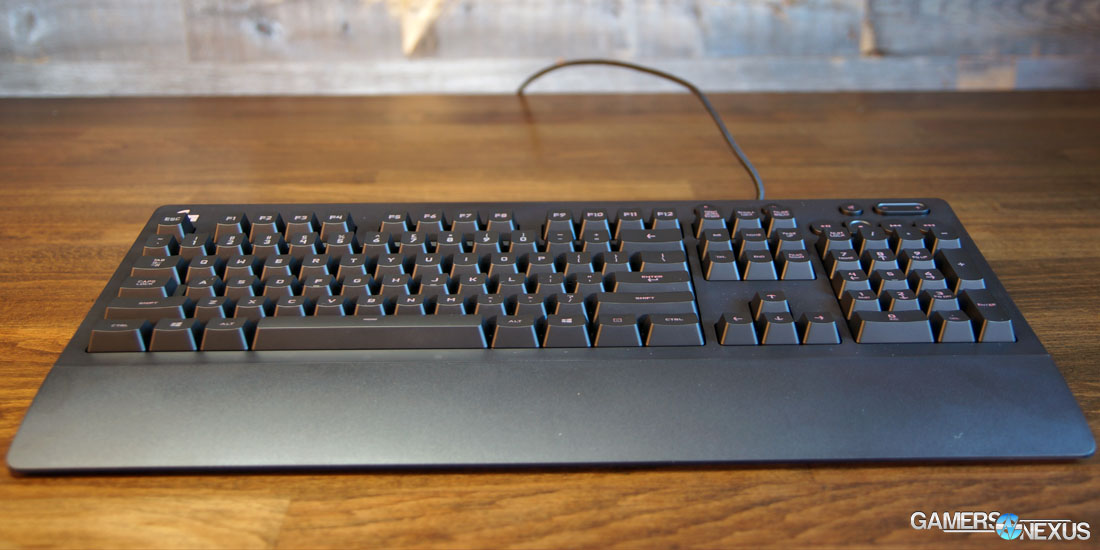Whenever we get a new keyboard to review, we make a point to put away the regularly used keyboards. It’s easy to gravitate toward what we’re familiar with, and so those things must be put aside for the review. Oftentimes, putting away the usual keyboards is easy since we have worked with a number of good releases lately, but sometimes it’s not so trivial.
Frankly, we expected the latter situation when unboxing the Logitech G213 Prodigy ($70). It’s a rubber dome keyboard, and those don’t get quite the fanfare that mechanical boards do. Setting the keyboard up revealed inclusion of RGB lighting, fully functional media keys, and a tuned force profile on the switches. The G213 also positions itself at a $70 “budget” price-point for an RGB board, but we’ll talk more about that later.
Logitech G410 Specifications
- Rubber Dome Switches
- 16.8M Color RGB Lighting
- ~6 Key Rollover
- Dedicated Media Keys
- Logitech Gaming Software
Water resistance - 2-Year Warranty
Typing, Gaming, and Media Keys
For those unfamiliar with our keyboard reviews, we go pretty in-depth with mechanical keyboards. So naturally, using a rubber dome keyboard was a little bit of a disappointment, but Logitech beat our (admittedly low) expectations by a decent margin. After unboxing the G213 and starting up a game, we noticed a difference between the G213 and the Strafe RGB with MX Silent Switches that we recently reviewed, but that difference wasn’t as substantial as expected.
Despite being rubber domes, the G213’s keys are neither too stiff nor too soft – something that always seems to be the case for rubber dome keyboards – and even though the switch has to bottom-out to actuate, there were never issues with a missed actuation during use. Counter to this, we also didn’t have issues accidentally actuating switches while gaming or typing, a problem we’ve encountered with the Speed Switches in the past. The only real complaint is that having to button-out to actuate the switch grows tiresome when writing lengthy articles, but that is inherent to rubber dome switches in general. Rubber domes aren’t going to be equivalent to mechanical switches, but the G213 is a good example of how they can meet half-way. The G213 has a “tuned force profile” that slightly modifies switch actuation requirements to more closely resemble the feel of a mechanical keyboard, but without implementing the more expensive switch assembly.
A quick side note related to typing: Logitech’s site doesn’t list the key-rollover amount, but some basic testing seems to suggest that it’s around 6-key rollover.
Logitech also included a built-in wrist rest, but it’s not detachable. Without the option to disconnect the wrist rest, we think the endeavor is largely pointless. Add the hinge and make it swappable for folks who don’t want the obstruction, or don’t bother including a wrist rest. We found it too short (both in terms of height and the amount it sticks out from the keyboard) to really support wrists while typing. Unfortunately, due to the non-detachable wrist rest on the G213, using a separate wrist rest isn’t really possible; as a result of this, we find typing for long periods of time on the G213 to be a little uncomfortable. This certainly won’t be an issue for everybody -- peripherals are still largely suggestive, at the end of the day -- but it’s one of the gripes that two of GN’s staff encountered.
On the other hand, we’re satisfied with the dedicated media keys on the Logitech G213. They use rubber domes which are somewhat squishy, but for media keys, it doesn’t really matter. The standard mute, volume up, volume down, pause/play, stop, and skip forward/backward buttons are there and fairly convenient for hitting quickly to change the song while doing other things. No separate Fn+ input is required, so these can be quickly activated with the mouse hand in between reloads. Fn+F-key media keys are more cumbersome to juggle and not feasibly used while actively gaming, leaving us to align with Logitech’s approach to media input.
Keycaps
Since the G213 uses rubber dome switches, it will be nearly impossible to find replacement keycaps. The default caps are decent, OEM profile. So far, they haven’t experienced any wear -- but we’re only a few weeks into testing. The keycaps are also the usual fare for RGB keyboards in that they allow for the for the light to illuminate the legend. There’s nothing revolutionary here.
Lighting
One of the Logitech G213 Prodigy's primary features is programmable RGB lighting. The RGB lighting is moderately bright, but even with the blinds drawn, they’re fairly easily drowned out in the afternoons. Similarly, the RGB lighting is somewhat customizable, but has some disappointing limitations. For example, there are only five vertical zones with which the color can be programmed. From about Alt to the Ctrl key is a single zone and keys within that zone can only be set to one color, making for what you’d expect in a budget RGB board -- limitations on what the controller can handle. There’s the usual breathing, color cycle, and color wave animations, all of which can be set to go faster or slower, with the color wave animation producing the most visible example of this “zone” system. The wave animation is somewhat strange looking, since each lighting section slowly turns the color of the section to the left, and is less fluid in RGB cycling than we’ve seen in other RGB LED devices this year.
The white is also somewhat teal-tinted – an issue we noticed on the G410, too. That’s pretty nit-picky, but keyboard lovers are nit-picky people.
Logitech Gaming Software
The lighting and other features – such as macros – are configured via Logitech Gaming Software. We’ve had no real issues with LGS in past reviews or in this current review; the software is among Logitech’s best-built products, integrating fairly seamlessly with multiple peripherals from other Logitech lines.
Like mentioned before, the lighting modes includes “FreeStyle,” “Fixed Color,” “Breathing Effect,” “Color Cycle,” and “Color Wave.” These modes all work fairly well, although the limitation of 5 lighting zones makes the color wave look a little odd if sitting there and staring at the keys. Overall, though, the lighting is without major flaw and still somewhat customizable.
A few side features in LGS offer enthusiast toys, like the key press heat map, and could be argued as a value add over some more software-lean competition.
Another major feature of LGS is macro functions. Any F-key can be set to perform one or more key presses, type out a block of text, execute a mouse function, control media (as in pause, play, etc.), open a program, execute certain functions (such as stopping/starting the heat mapping function), or control mics via VOIP. We’ve deployed LGS for macro mapping in MMORPGs in the past, where intricate macros can be built for ability and spell chains that are almost always cast together. Macros are impressively customizable and functional with the G213, aided in usability by a relatively shallow learning curve. You won’t be able to map macros to non-F keys with this board, but that’s really not unexpected.
As for profiles, Logitech Gaming Software allows for game-specific profiles that often include pre-mapped or suggested functions. This allows for LGS to automatically apply certain lighting and macro settings if a game is launched, with some games (like Bioshock and Left 4 Dead 2) already offering pre-made profiles with suggested functions. It also has profiles for Microsoft Excel, although we’re not sure how relevant that is for a keyboard marketed towards gamers.
Build Quality and Aesthetics
The Logitech G213 has fairly solid build quality, even though it lacks a metal backplate that many keyboards have. The plastic shell does a good job of preventing flex for the most part; only when specifically attempting to stress the board into flexing does it give, and we can’t say that our metal-plate keyboards give in the same fashion. But again, you’ve got to exert some effort to get that response. Only FPS Doug types like that.
The exclusion of a metal backplate has allowed for the G213 to be fairly light at 2.8lbs. The cable is solidly attached and is braided (which both looks good and should help prevent it from breaking), but it is unfortunately not detachable, so custom cables and/or replacing a broken cable isn’t possible.
The interior build quality is good, but there’s not a lot to be perfected with rubber domes. There’s little opportunity for error in this type of switch -- they just don’t need to be soldered, and the absolves the G213 of potential unclean solder complaints or clean solder praise. The G 213 has a thin plastic backplate that helps to add rigidity to the board, implemented in a way that doesn’t add substantial weight or cost.
The Logitech G213 Prodigy is also water resistant, which is somewhat useful. In theory. For those more clumsy (or careless) out there, or maybe those with kids, this may be a useful feature. We observed a live demo for the G213’s unveil where Chris Pate, one of the Logitech G team members, poured a pint of beer on the keyboard without any loss of lighting or input to the host system.
The G213 uses an ST Microelectronics STM32L100 32-bit ARM processor as the controller, which is the same controller found in the G410.
In terms of looks, the Logitech G213 is fairly plain when the lights are turned off. But that’s not a bad thing. There are no frills or edgy decorations to detract from the fact that this is, in fact, a keyboard; you could put the G213 on a desk at work and not be shunned for it, and it’s not quite got that try-hard look that some of Corsair’s “sleek” units have. Each part of the G213 keyboard looks cohesive; there are no afterthought wings and plastic appendages on this one.
Conclusion
When we originally unboxed the Logitech G213 Prodigy, we expected to be disappointed by having to use a rubber dome keyboard again. Rubber domes have fallen out of vogue, and although we know plenty of our readers still prefer the cost or feel of rubber dome keyboards, our staff have largely become accustomed to gaming on mechanical boards. Except GN’s Steve -- he just uses whatever is nearby. But that’s his problem.
We ended up being reasonably satisfied by the G213. It features somewhat customizable RGB lighting, is resolute in its build quality, and offers the usual powerful macro system from Logitech.
The G213 Prodigy currently retails at $70, which is both decent and slightly disappointing. On one hand, the G213 Prodigy brings customizable RGB lighting at a cheaper price point than has been common (even for rubber dome keyboards). On the other hand, it has unwavering competition with the Cooler Master Lite L at $60 with very similar features (the primary difference being dedicated media keys). On top of that, the Logitech G213 Prodigy has to compete with lower-end mechanical keyboards like the Thermaltake Poseidon Z ($63) (which we reviewed here) that may not have RGB lighting, but do have basic backlighting and mechanical switches.
For those wanting a minimalistic, RGB, membrane keyboard with macro abilities and dedicated media keys, the G213 is a good choice at $70. It’s also the only choice, really, with most membrane boards now dying out at the high-end. Anyone who cares more about budget and can sacrifice media keys may instead want to look at Cooler Master’s Lite L ($60) is likely a better choice, and for those who really want mechanical switches, the Thermaltake Poseidon Z ($63) is a better choice still. The G213 would be much more competitive with a $5-$10 price drop, but it’s still competitive in its niche market. There are no better membrane options out there right now, of that much we are fairly confident.
- Michael "The Bear" Kerns.
